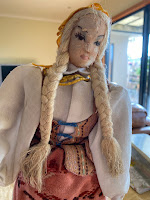The book Benamiai (Homeless) written in Lithuanian recently found its way into the Archives. Because it was published in Buenos Aires, 1954 I gave it some attention. To my surprise the book was about Australia. It begins in the DP camps of Germany, the ship to Australia and then the next few years as a new migrant.
A few Google searches later, I found that it was written by Dr. Juozas Mikelionis.
Finding his obituary online, I found that Juozas was born in 1915 and passed away in 2008. He was a retired physician and author, whose life touched six continents.
Born in Leipalingis, Lithuania, he went from farm lad to physician, graduating in 1940 from Vilnius University. As his homeland suffered the tragedies of Communist and Nazi occupation, he himself was forcibly transferred to Germany. After the war he lived in Germany. 1944-1945 worked at Spandau Hospital, 1945-1946. was chief assistant and surgeon at the Orthopedic Clinic of the University of Heidelberg (granted the title of surgical specialist in 1946), 1946-1948. - Surgeon of the Kempten and Bad Worishofen Refugee Camp Hospitals. In Kempten, he organized the courses of the Sisters of Mercy, was their lecturer and director.
Seeking promises of work as a physician, he left ravaged post war Germany for Australia where the family endured tough times in refugee and migrant camps.
A very accomplished doctor who could speak French, Polish, German, Russian and English.
His book talks about the migrant camps and the two year work contract, the Australian government required of the new migrants. He quickly became disillusioned, as his education was not recognized or utilized.
We were disappointed to learn that the best position we would get was as a medical orderly or hospital wardsman. … If you asked for a particular type of work or place, they would give you the opposite. If you asked to go to Sydney, you would be sent to Adelaide.
Having experienced life in Europe, he found Australians to be lacking in culture.
Many Australians don’t know their own country, don’t know the size of their country, or its people, or history, they are ignorant about the Aboriginal people. They don’t want to know about anyone else, they won’t admit they are ignorant. Australian’s only like those who are born here. Many who come here, even the English, return home. Those who can’t, suffer.
He tried to settle in Australia, he searched for medical work, writing over 100 application letters. Some of the responses were mockingly cynical. All my efforts to stay in Australia and help the people of this country with my learned craft were rejected by the Australia.
His disillusionment with Australia, saw him, his wife and young son. migrate to Argentina, where he worked in hospitals. In 1958, he finally was allowed to immigrate to the US. He persevered in obtaining medical licenses first in Illinois and then in Washington.
Washington remined him of Lithuania and he enjoying the strong Lithuanian contingency there. He set up a family practice in Seattle before working for the Boeing Company for twenty years, retiring in 1982.
He wrote another book, Physician at the Crossroads published in 1991 (Carlton
Press, Inc.).
A very valuable book about new migrants in Australia.
Obituary from
Published by The Seattle Times from Feb. 23 to Feb. 24, 2008.
https://www.legacy.com/us/obituaries/seattletimes/name/juozas-mikelionis-obituary?id=28818125

















